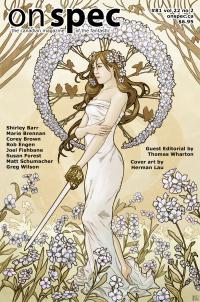 “Still” by Greg Wilson
“Still” by Greg Wilson
“The Spectacular Death of Billy Nichols” by Joel Fishbane
“Thanks for the Game” Rob Engen
“Pharaonic Park” by Shirley Barr
“The Last Wendy” by Marie Brennan
“The Right Chemistry” by Susan Forest
“The Asheville Road” by Corey Brown
Reviewed by Bob Leishman
I don’t really warm up to stories containing puppets so when I began reading “Still” by Greg Wilson, I was afraid that this was one that I’d have to plough through. Nevertheless, as I read, the story began to develop into something special.
Still, a young puppet, lives in a city populated by puppets who have no strings. They were freed some generations ago by Key the Cutter and tying strings to these puppets is a form of incarceration. So they have free will. Still’s Father is a paper folder and her mother is a painter. Each day she paints new faces on puppets at their request (happy, sad, etc.)
When Still suffers a trauma that involves a secret, she leaves home and finds her way to a run down part of town, kind of shabby and populated by puppets that are in some way damaged or less distinct than they might be. It’s here that Still must find herself and a solution to her problem.
Wilson doesn’t just animate his puppets for us, he humanizes them.
At some point in the future, technology enables people to record their dreams for later playback and even broadcasting. Joel Fishbane in “The Spectacular Death of Billy Nichols” gives the story two angles: a new medium being exploited by the networks which control it, and the effect it has on the life of Billy Nichols.
Bill Nichols, a University Professor who’s been forced into early retirement, gets a shot at fame and fortune when he records a dream which includes his own death. This is rare in the industry and the network snaps him up. But there are complications. An organization simply known as the union is opposed to canned dreams as a form of entertainment and Nichols’ personal life becomes complicated with an extramarital affair and a midlife crisis that doesn’t seem to go away.
Joel Fishbane creates in Billy, or Bill Nichols, a character who both resists change and simultaneously embraces it to his own despair. The character development alone makes this worth a read. (For a much earlier exploration of the idea of the commercialization of recorded, “canned” dreams, see Isaac Asimov’s “Dreaming is a Private Thing” from the December 1955 issue of The Magazine of Fantasy & Science Fiction.)
On Spec is of course a Canadian Magazine and what could be more Canadian than a story about hockey? In “Thanks for the Game” Rob Engen has a trio of bug like aliens landing in Brandon, Manitoba in the dead of winter. The Canadian government responds with a typical manoeuvre–wait to see what happens. It’s when an alien encounters the story’s narrator, Tom, a player in the NHL who’s been sidelined by a preseason injury at an outdoor rink, that the hockey angle really begins to kick in.
Tom reflects not just on aliens, the government, and the state of the world but on the game itself and that’s where the story gets very interesting. A good read for any proud Canadian.
When I think of a theme park or a theatre I always want to look backstage to see the machinery, the actors and the chaos that leads to a great performance. In “Pharaonic Park” Shirley Barr gives us a unique look at the players in a theme park.
The formal name of the story’s narrator is Tutankhamen Nebkheperure and he’s about to be crowned King Tut in a park devoted to the Pharaohs. A clone of the original Tutankhamen, and still only a boy, he indulges walking amongst the crowds as if he were a commoner, or a player of a much smaller part. As he walks about he encounters another clone, evidence of the commerce that runs the park–and a couple of nasty tourists.
He’s no kid actor, he’s a clone. Not a prince born to claim a throne but a being created to claim an identity which includes one. This story deserves a read simply to meet this character.
Peter Pan is the boy who lives in Neverland and only occasionally returns to London to pick up Wendy for a return trip home and spring cleaning; only this time things are different. Over the years Wendy has been replaced by Wendy’s daughter, granddaughter, etc., and as the story opens Peter is discovering Angie, someone who’s a far cry from the original Wendy.
In “The Last Wendy” Marie Brennan gives us Wendy’s descendent, Angie, a contemporary, streetwise girl being raised by her dad in a house that’s grown very old. Although aware of the family history concerning Peter she doesn’t leap at the chance to literally take off with him. The story offers closure but might not appeal to diehard fans of the boy from Neverland.
“The Right Chemistry” by Susan Forest has chemistry, real chemistry in terms of the more chemistry you know the more laughs or insight you may get from it. But even I, who slept through high school chemistry, got enough out of it to appreciate the twist at the end.
Corey Brown in “The Asheville Road” gives us an alternate history of the railway in nineteenth century rural America against the backdrop of a failed romance–of two people brought back together by circumstance. I’m not a fan of alternate histories, but did appreciate the level of detail the author provided for the technology of this America. The story also has some worthwhile character development.
On Spec‘s website is here.